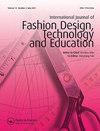不断发展的模式实践,从传统模式到定制的参数块
IF 2.2
Q3 BUSINESS
International Journal of Fashion Design, Technology and Education
Pub Date : 2023-10-20
DOI:10.1080/17543266.2023.2260829
引用次数: 0
摘要
参数化和传统的CAD方法是模式构建的基础。本文对其几何数据输入、构建空间、方法、工作流程和输出进行了实证分析,突出了两者之间的差异。结果表明,传统方法的数据输入速度较快,但缺乏可编辑性;参数化方法的数据修改效率高,但需要更多的初始输入时间。传统的方法允许更快的构建,但是对于重要的模式更改会变得非常耗时,而参数化方法虽然构建速度较慢,但提供了可编辑的块,以便进行有效的修改。参数化方法捕获几何形状和块逻辑,而传统方法只关注几何形状。参数化方法支持定制服装的创建,减少浪费并促进可持续性,而传统方法导致静态块,需要每个新穿着者的娱乐。因此,教育机构应率先向参数化方法过渡。本文章由计算机程序翻译,如有差异,请以英文原文为准。
Evolving pattern practice, from traditional patterns to bespoke parametric blocks
The parametric and traditional CAD approaches are fundamental for pattern construction. This paper empirically analyses their geometric data entry, construction space, methods, workflow, and outputs, highlighting differences between the two. The results show that the traditional approach offers faster data entry but lacks editability, while the parametric approach prioritizes data modification efficiency despite requiring more time for initial entry. The traditional approach allows quicker construction but becomes time-consuming for significant pattern changes, whereas the parametric approach, although slower to construct, offers editable blocks for efficient modification. The parametric approach captures both geometric shapes and block logic, in contrast to the traditional approach's focus solely on geometric shapes. The parametric approach supports the creation of custom garments, reducing waste and promoting sustainability, while the traditional approach leads to static blocks necessitating recreation for each new wearer. Accordingly, educational institutions should spearhead the transition to the parametric approach.
求助全文
通过发布文献求助,成功后即可免费获取论文全文。
去求助
来源期刊

International Journal of Fashion Design, Technology and Education
Arts and Humanities-Visual Arts and Performing Arts
CiteScore
3.10
自引率
0.00%
发文量
36
 求助内容:
求助内容: 应助结果提醒方式:
应助结果提醒方式:


